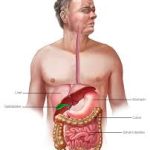
DO YOU SUFFER FROM DIGESTIVE ISSUES ?
Maybe you suffer from gas, bloating, constipation, diarrhea or other digestive problems- may I suggest your first attempt to remedy this by stopping all gluten in your diet, but if this is unsuccessful please look at utilising the following.
The likely cause of your continued digestive problems lies not in what foods you are eating, but what foods you are eating together.
You see different types of foods require different kinds of digestive enzymes to be broken down. When you eat foods together that require complimentary digestive enzymes (acid or alkaline enzymes, but not both) your digestion is accomplished easily and efficiently. That means no gas, bloating or heartburn, and normal bowel movements.
But when you eat foods together that require digestive enzymes that are opposite on the pH scale (acid AND alkaline enzyme mixed) the enzymes combine and neutralize in your stomach. When this happens, your digestion comes to a sudden halt.
Your stomach will sense trouble is brewing and try to secrete more enzymes, but it is to no avail because they to become neutralised. This process can go on for 8 hours or more and result in excess stomach acid which can, in turn, slide up your esophagus and lead to heartburn, acid reflux, and GERD.
In this scenario, things don’t improve once your foods leave your stomach. Because your digestion has been impaired, your foods are not broken down like they should be when they enter your intestines. This leads to the familiar gas, bloating and bowel problems (constipation and diarrhea).
How to avoid poor combinations of food.
Good news its very easy to adjust your diet to ensure that all of your meals (and snacks) are well combined and easy to digest.
You just need to remember three simple principles:
1: Avoid eating concentrated proteins and starches together (or within 3 hours of each other).
2: Eat fruit alone on an empty stomach.
3: Avoid processed food.
- Avoid the protein-starch combination.
Proteins require an acid digestive enzyme to be broken down, and starches need an alkaline enzyme. So when you eat both of these foods together, the acid and alkaline enzym
es neutralise each other in your stomach, and your digestion stops like I described above.
On the next page is a chart that will serve as a guide to knowing what food pairings work well. You can mix gluten-free versions of foods from Columns A and B together, or from Columns A and C together, but NOT from B and C together.
So Remember
A + B = OK
A + C = OK
B + C = PAIN !

B Eat Fruit on an empty stomach.
This is probably the most important of the 3 food combining principles for people living a gluten-free lifestyle. Since people with gluten sensitivity or celiac cannot eat the traditional cake, cookie or pie, a common suggestion is to have fruit for dessert.
But this can have disastrous consequences and make you feel like you’re having a gluten “attack” Here’s why:
Fruit is a food mainly made up of water and natural sugars. As such, it doesn’t take much effort for your system to digest it. With the exception of more dense fruits (bananas, avocados and dried fruits), when fresh fruit is eaten, it passes right through the stomach and into the small intestine where it’s digested.
This is fine when your stomach is empty…. But the problems arise when your stomach is full of other foods and is working to digest them and you toss fruit on top of them. At that point the fruit wants to head to the small intestine but its passage is blocked by other food. So the fruit gets stuck sitting on top of those foods in the stomach and quickly starts to ferment and putrefy.
What happens at that point? Stomach aches, gas, bloating. Diarrhea and cramps. And you head for the antacids.
What you need to do instead is eat fruit but eat it on an empty stomach—- either (alone) for breakfast, as a snack (at least 3 hours after a properly combined meal) or as a first course of a meal, allowing at least 20 minutes for the fruit to pass through the stomach before other foods are eaten.
C Avoid Processed Foods.
Processed foods are the single most harmful and insulting attack on human health.
Simply put, processed foods are anything in a jar, box, can, or bag with hard to pronounce ingredients. Many have an indefinite shelf life in your pantry. They don’t spoil within a few days of your buying them, like real food does.
Processed foods start out with real food ingredients…. But then those ingredients are completely violated and destroyed through one or more processes- heating, bleaching, drying, fragmenting, freeze drying, evaporating, etc.- until they in no way resemble the real food they started out as.
Then various chemicals are added (over a billion pounds of chemicals are added to processed foods in America each year!) that serve a variety of purposes- colouring, preservatives, artificial flavours, appearance enhancers, texture modifiers, plus some good old vitamins and nutrients since the original ones in the food have been “processed out”.
These chemical creations provide no benefit to your body whatsoever. Even if the box says the contents are healthy, they are truly not. On the contrary, not only are they not healthy, they’re harmful.
- No nutrients
They provide no usable naturally occurring nutrients; they use up loads of digestive energy, and then basically turn to nothing but waste.
- No Water
They contain no water to transport nutients or carry away wastes from your body. Instead, they add to the waste pile, making you more toxic.
- Hungry again and again.
Your body’s hunger feeling is triggered by a need for nutrients from real food– not just something to occupy space in the stomach. Since processed “foods” don’t nourish you, even though your stomach may be physically full, your body thinks it still needs more food because it hasn’t gotten nourished. That’s why you can polish off an entire family-size bag of your Favorite snack chips, then feel hungry again an hour later. The resulting ,effect, naturally, is weight gain.
- The Gluten concern
Virtually ALL processed foods contain gluten, unless they are specifically labelled gluten-free. But even if they’re gluten-free that doesn’t mean they’re good for you.
These articles are from a great book Called “Great Taste No Pain” or GREAT TASTE NO GLUTEN
These books can be researched and purchased if desired from
www.greattastenopain.com
If you cannot read the list please contact us and we will supply this.
